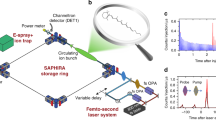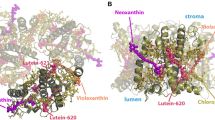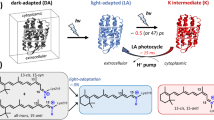Summary.
Using simultaneous two-photon excitation of fringelite D and a fluorescence indicator embedded in a vesicle system it was demonstrated that after excitation a proton was transferred from the pigment to the indicator similarly as recently documented for hypericin. Semiempirical AM1 calculations were used to show that the radical species formed by electron transfer from the excited pigment state constitutes an acid which is therefore well suited for intermolecular proton transfer. Accordingly, this process constitutes a suited candidate for the primary photoprocess in the signal transduction cascade of the photosensory pigments of the stentorin and blepharismin type.
Similar content being viewed by others
Author information
Authors and Affiliations
Additional information
Received April 26, 2000. Accepted May 16, 2000
Rights and permissions
About this article
Cite this article
Immitzer, B., Etzlstorfer, C., Obermüller, R. et al. On the Photochemical Proton Expulsion Capability of Fringelite D – A Model of the Protist Photosensory Pigments of the Stentorin and Blepharismin Types. Monatshefte für Chemie 131, 1039–1045 (2000). https://doi.org/10.1007/s007060070035
Received:
Accepted:
Published:
Issue Date:
DOI: https://doi.org/10.1007/s007060070035




